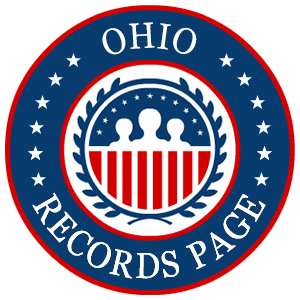Look up free Ohio divorce records and obtain them via various agencies.
Most divorce and dissolution of marriage information can be viewed online through resources provided by the clerks of the various county courts; the official copies of these records are also available and can be accessed through the domestic relations courts. Copies of decrees are also available to authorized individuals.
This resource provides concise instructions on how to search and acquire these records on anyone who finalized their divorce in Ohio.
Can Members of the Public View Divorce Records in Ohio?
As part of the umbrella Sunshine Laws, the Ohio Public Records & Open Meetings Laws govern how government records are available to the public.1
The laws stipulate which records are available, which records are not, and the process of accessing these records. The law extended to cover vital records such as divorce records, which are considered public records in Ohio.
Specifically, Section 149.43 of the Ohio Revised Code gives citizens the statutory right to search public records, including divorce records.2
There is no statewide search for divorce records in Ohio as these records are only available at the county level. Most counties, through the court of clerks, provide online access to these records. Individuals can search and view these records online.
It is important to note that decrees, which contain more detailed information about the divorce, are only available to the parties to the divorce and their legal representatives. These copies are also available through the various clerks of courts where the ceremony was recorded.
Data on Ohio divorce rates shows that in 2022, the total number of married men stood at 3,010,021. Out of this number, 30,115 divorced last year. Similarly, out of the 4,922,185 married women, 33,206 divorced last year.
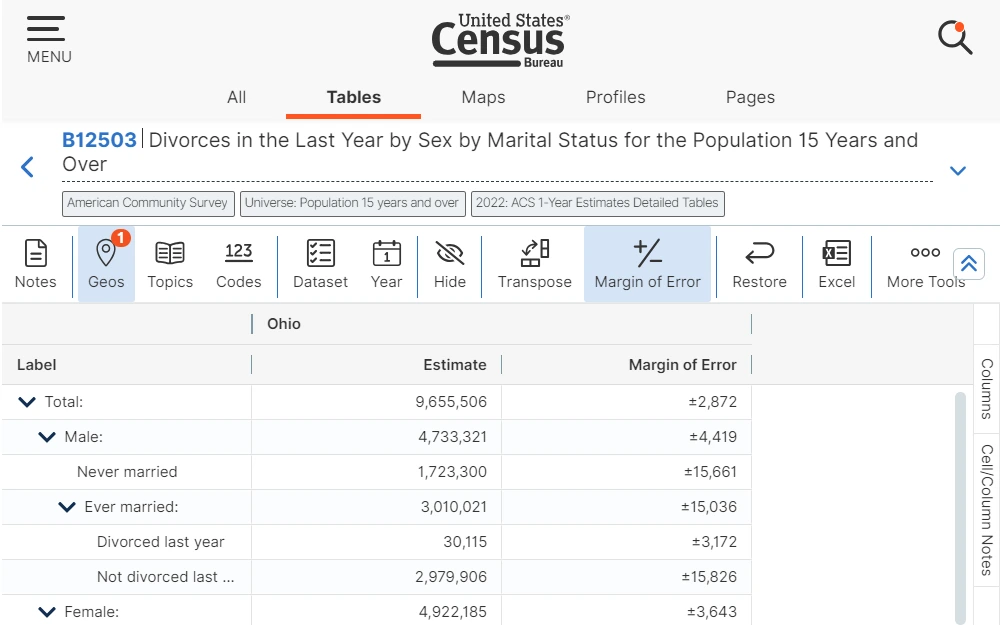
The Ohio Department of Health goes back further, providing reports on divorces dating back to 1990. Between 2016 and 2020, the number of marriages and divorces has been declining.
In 2020, out of 56,060 marriages, there were 28,916 divorces. Allen County led with the highest number of divorces at 3,255 while Wyandot County registered the lowest number, at 34.
The table below shows the number of marriages and divorces in the state from 2016 to 2020:
| Year | Total Marriages | Total Divorces |
| 2020 | 56,060 | 28,916 |
| 2019 | 62,295 | 32,365 |
| 2018 | 65,660 | 33,969 |
| 2017 | 67,867 | 34,124 |
| 2016 | 69,177 | 35190 |
How To Find Ohio Divorce Records for Free
Although the Ohio Bureau of Vital Statistics maintains vital records, the state does not have a statewide divorce index. Since 1911, each county in the state has been maintaining its own records of divorces through the probate courts.
To access these records, searchers can review this list of county clerk offices in Ohio to find information on the applicable county where the divorce in question occurred. For inquiries, individuals can contact the Bureau by calling 614.466.2531 or visiting them at the address listed below:
Ohio Bureau of Vital Statistics
4200 Surface Road
Columbus, OH 43228
The Supreme Court of Ohio Opinion Search is a great way to look for divorce cases that were appealed. This online search index allows individuals to search for cases from 1992 to date through all the District Court of Appeals in the state.

You can search by name, case number, author, citation, or WebCite number. If the record you are looking for is available in the database, you view its history through the trial courts and the decision of the District Court of Appeals.
Obtaining Divorce Records Through Counties in Ohio
A statewide search for records often offers the broadest results. However, in the case of Ohio, where a statewide index is not available, the county-level search for divorce records becomes the best alternative. This option has its advantages, as a more localized search through counties narrows the scope of your research.
In addition, county offices offer various options for requesting these records, in-person requests included, where searchers can get more personalized help from county staff. Some examples can be found below.
Starting with Franklin County divorce lookups, the County Clerk of Courts and the County Data Center maintain an online database of divorce records through the Case Information Online (CIO).5 By conducting either a name search or case search on the CIO, record seekers can view divorce records for free.
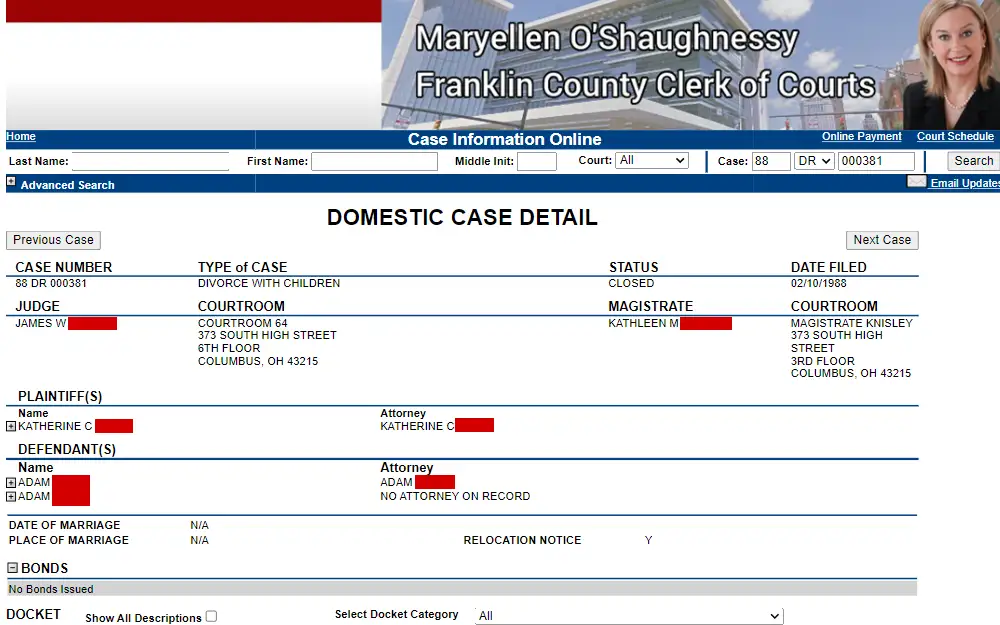
Individuals can obtain certified copies of the decree at a cost of 10 cents per page and a certification fee of $1 per copy.
You are required to send a written request to the Domestic Relations Division of the Court of Common Pleas. In your request, include the name of the parties to the divorce, the filing date, case number if known, and your return address.
This request should be mailed to the address below:
Franklin County Clerk of Courts
373 S High Street, 4th Floor
Columbus, OH 43215
For related inquiries, searchers can call the Domestic Relations Division at 614.525.4410 or physically visit the office on the 4th floor at the address shown above. The office is open from Monday to Friday, 9 AM to 5 PM.
A matching name search reveals the details of the divorce, including whether children are involved, whether the case has been closed, the case number, the judge, as well as a history of the case from inception.
The County Clerk of Courts is the custodian of divorce records in Cuyahoga County. Divorce cases in the county are heard and settled by the Domestic Relations Division of the Common Pleas Court. Individuals can view these records by conducting a search through its free public divorce records search system.
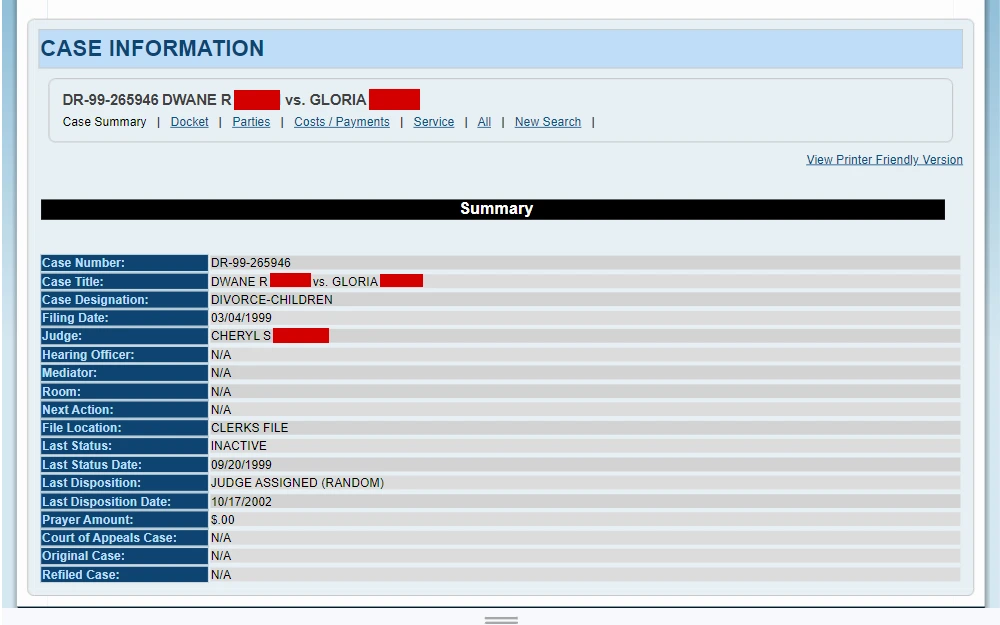
This online database allows individuals to search and view records of both civil and criminal cases. Searchers are required to conduct a search either by name or case number and enter the search criteria that include the names, party role, case category, and case year. To search for divorce records, choose “Domestic Relations” from the case category.
If your name search matches, details such as the name, address, and case number are shown.
Click on the case number to view further details about the case, which includes the case summary, details about the docket, parties to the case, and the payments made by the parties.
For certified copies, individuals can call the Justice Center at 216.443.7977, email them at [email protected] or call the Domestic Relations Division at 216.443.7955. You can also visit the two offices using the addresses below:
Justice Center
1200 Ontario St., 1st Floor
Cleveland, OH 44113
Domestic Relations Division
Old Courthouse
1 Lakeside Ave, Room 35
Cleveland, OH 44113
Looking at Hamilton County, the process of obtaining divorce records is a little different. The Court of Common Pleas, Division of Domestic Relations which is responsible for hearing and settling divorce cases, does not provide online access to these records.8
However, individuals can still request access to these records from the Hamilton County Clerk of Courts office. Searchers can obtain copies of divorce decrees granted between 1885 to 1994 by calling the Document Center at Hamilton County Courthouse at 513.946-5693.
Additionally, individuals can visit the office in Room 315 using the address shown below:
Clerk of Courts
1000 Main Street,
Hamilton County Courthouse
Divorce records from 1994 to date can be obtained from Hamilton County’s Clerk of Courts. Individuals can call the office at 513.946-9150 or visit Room 3-47 at the address below. Both offices are open from Monday through Friday, 8 AM to 4 PM.
Clerk of Courts
800 Broadway,
Cincinnati, OH 45202
For one final example, interested parties can use the guidance found in the Lucas County divorce lookup instructions for guidance on obtaining dissolution records within the county.
Tracking Family Heritage & Genealogy via the County Records Centers
Since 1913, individual counties in Ohio have been filing divorces in the Domestic Relations Division of either the Probate or Court of Common Pleas. Some counties in Ohio have archive centers or microfilm departments that can be of help to individuals tracking their family heritages.9
For residents of Trumbull County looking for archived divorce records, the Records Center and Archives Department maintains records of divorces and dissolutions in both microfilm and file formats.
Divorce records in microfilm format are available from 1978 to 1987, divorce files from 1987-1991, and dissolutions from 1979 to 1992.
Searchers can email the Recorder’s Office at [email protected] or visit from Monday to Friday, 9 AM to 4 PM. Record seekers can also visit the office on the first floor at the address indicated below or call 330.675.6615 for inquiries.
Trumbull County Records Center & Archives Department
185 East Market St., Ste B
Warren, Ohio 44481
Trumbull County Record Center further helps with genealogical research questions through its genealogical society. The address of the office is shown below:
Trumbull County Genealogical Society
PO Box 309
Warren, Ohio 44482
Stark County encourages searchers to reach out to its Record Center for requests related to genealogy research.10 You can email the office at [email protected] or write your request and send it to the address listed below. In your request, remember to include the name of the parties whose records you seek and the approximate date the record was filed.
Stark County Records Center
201 Third Street,
N.E., Suite 5, Canton, Ohio, 44702
The Montgomery County Records Center & Archives also accepts research requests for records if it is available.11 To facilitate this request, you should specify as much information as possible about the subject, including name, related dates, and the type of record you seek.
Archived divorce records dating from 1876 to 1949 are available from the department. If you are looking for divorce records from 1949 to date, call the Montgomery County Clerk at 937.496.7623.
To obtain older records, you can visit the Records Center and Archives, whose office is located on the 6th floor of the Reibold Building. The address is listed below:
Montgomery County Records Center & Archives
117 South Main St.
P.O. Box 972
Dayton, Ohio 45422
Generally, archived marriage records are easier to find than divorce records since these marital events were documented in multiple places, including in churches and by civil authorities. However, earlier divorce records can only be found through court records or individual county archive centers if the said county has digitized its documents.
That said, there are various libraries and historical societies that have gone the extra length of digitizing older marital records. These libraries can help you search through their vast databases or even assist you in your genealogy quest. Some of these institutions are listed below:
- Akron-Summit County Public Library
- Columbus Metropolitan Library
- Licking County Genealogical Society
- Tuscarawas County Genealogical Society
Common Law Marriages & Divorces in Ohio
According to Ohio Revised Code Section 3105.12, the state recognizes common law marriages entered into until October 1991.
For the union to be deemed as “common law” marriage, both parties are required to have presented themselves as married and involved in what normal couples do. These could be joint tax returns and bank accounts, entering into mortgage agreements, or signing loan contracts.
The state does not recognize common law marriages entered into after 1991, and partners are encouraged to seek marriage licenses. Like in a solemnized marriage, the dissolution of a common law marriage follows the same process, especially in regard to the custody of minor children and the division of property.
Various cities in Ohio have established domestic partnership registries. These include Columbus, Cleveland Heights, Yellow Springs, and Franklin, among other cities.
Each county has its own requirements for the domestic partnership, as well as the associated costs. Rule 3337-40-13 of the Ohio Administrative Code even goes further to list the various benefits these partners are eligible for.12
If the domestic partnership was registered, then the partners need to submit a notification of its termination. For instance, in Columbus, each member of the partnership is required to notify the City of Columbus about the dissolution of the relationship by submitting a Notice of Termination Form.13
In Cleveland Heights, the process is similar, where one or both partners can fill and sign the Domestic Partnership Termination Form and return it to the city’s administrative office. It is important to note that the termination of a domestic partnership is free.
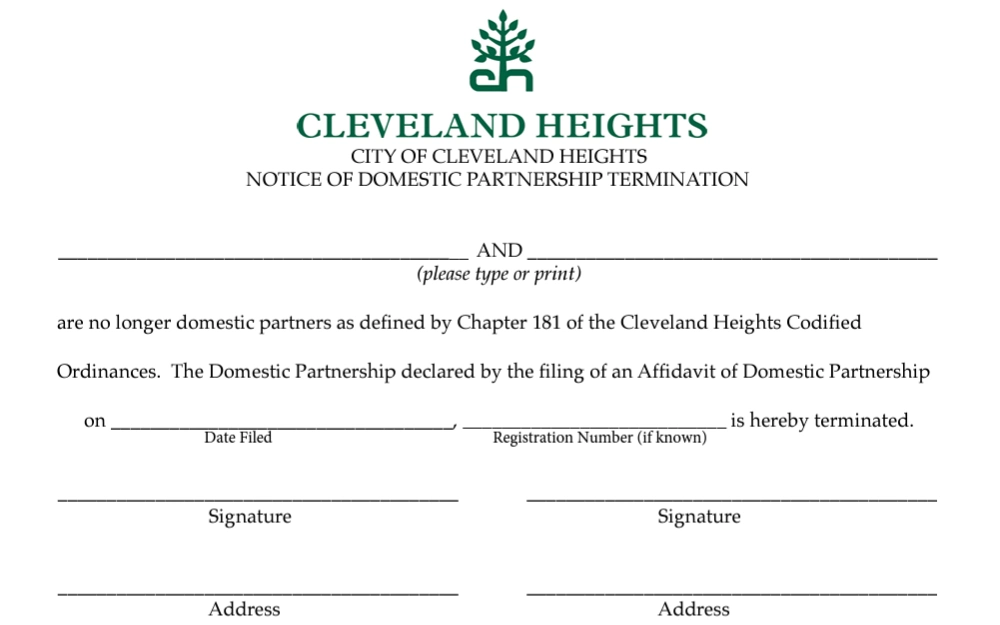
How To Determine if Someone Had a Dissolution of Marriage or Is Common Law Divorced in OH
There is no centralized database for divorce records at the state level in Ohio, as these records are kept at the county level.
Since both formal and common law marriages follow the same legal process when coming to an end, these records can be obtained from the various Clerks of Courts at the county level.
In Ohio, a marriage can end through termination, divorce, dissolution, annulment, or separation. For common law marriages or domestic partnerships, both partners can mutually agree to terminate the relationship and agree on property division.
The process of finding a “common law divorce” record is the same as finding any other type of separation. In case the partners went to court to settle matters concerning property, individuals can look up these records at the county level. The process of obtaining this information has been explored in depth in the divorce records section.
Records of domestic partnerships are available at the city and county levels in Ohio. Since these are public records, individuals can contact the county or city clerks using the details in the table below:
| City | Address | Contact Number |
| Columbus | City Council 90 West Broad St. Columbus, OH 43215 |
614.645.7380 |
| Cleveland Heights | City of Cleveland Heights 40 Severance Circle Cleveland Heights, OH 44118 |
216.291.5795 |
| Dayton | City of Dayton 101 W 3rd Street Dayton, Ohio 45402 |
937.333.3333 |
| Cincinnati | Cincinnati City Hall 801 Plum St., Cincinnati, Ohio 45202 |
513.352.3246 |
| Oberlin | Oberlin City Hall 85 South Main St., Oberlin, Ohio 44074 |
440.775.7203 |
| Athens | Office of the Mayor 8 E. Washington Street Athens, Ohio 45701 |
740.592.3338 |
How To File for a Divorce & Address Divorce Petitions in Ohio
A marriage can end through divorce or dissolution, depending on how the partners agree.
A dissolution, also known as a non-contested divorce, arises through an amicable agreement between the partners regarding custody and prenuptial agreement. In the case of a dissolution, the partners must first sign a separation agreement, which the court must verify.
Dissolutions normally have a set period to be determined and settled, between 30 and 90 days, while divorces can drag on for years. A contested divorce usually arises if the parties cannot amicably end the union, and the partners can file either a for-fault or no-fault application. In case the partners opt for dissolution, the court must still issue a final decree before issuing a divorce certificate.
Although individuals can represent themselves, it is always advisable to seek legal counsel before, during, and after the process. Additionally, it is advised and encouraged to seek amicable means of ending the union rather than filing for divorce, as the process can be time-consuming and expensive.
An attorney can advise on the laws surrounding divorces in the state, the process of filing, and the related fees. Even when both parties agree on dissolution, make sure you have legal counsel to guide you in the equitable division of property and custody of children, if available.
Chapter 3105 of the Ohio Revised Code outlines the various codes individuals should be aware of when filing for divorce:
- Section 3105.01 lists the grounds for divorce, which can either be no-fault or at-fault reasons. The grounds for no-fault divorce include incompatibility, while at-fault divorce reasons range from adultery to extreme cruelty.
- Section 3105.011 notes that a divorce should be initiated in the court of common pleas in the county of residency.
- Section 3105.03 states that the person filing for divorce must have been a resident of Ohio for at least six months at the time of filing.
- According to Section 3105.08, a divorce can be converted into a dissolution by filing a motion.
- Section 3105.091 notes that the court of Common Pleas can allow the parties to the divorce to take a mediation approach for a period of 90 days or less.
- As per Section 3105.171, Ohio takes an equitable approach to the division of property during divorce.
Other notable stipulations in Chapter 3105 include child support, child custody, and spousal support for your ex-wife or ex-husband.
In the case of alimony, either suppose can be ordered to support the other, and this decision is based on income, age, physical and mental health, as well as the standard of living. This criteria also applies to child support.
The associated fees and process of divorce, annulment, or dissolution vary per county. In Franklin County, both the divorce and dissolution can take place with or without children. The filing fee for a divorce with or without children is $250, while the fee for a dissolution with or without minor children is $200.
Cuyahoga County requires that the party filing for divorce must have lived in the county for at least 3 months at the time of filing. As the defendant, you have 28 days to respond to the petition, otherwise, the Court of Common Pleas schedules an uncontested hearing.
Individuals can either file for divorce via mail by first downloading and filling out the separation and divorce papers or through E-Filing.15
The filing fees include $300 for divorce with children and $200 for divorce without children. For a dissolution, the filing fees are $200 if the parties have children and $150 in case there are no children.
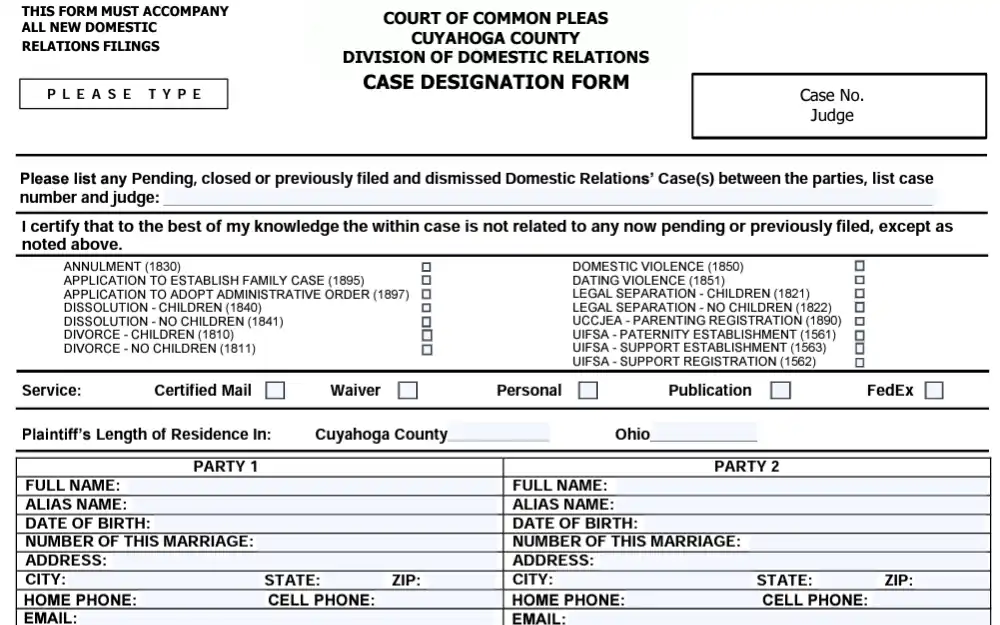
In Hamilton County, either party can initiate a divorce by filling out and submitting a divorce form in person or via mail. The filing fees for both divorces and dissolutions are $375 if children are involved and $325 if there are no children.
There are various reasons for wanting to obtain divorce records, such as for tracing family history; the court of common appeal in each county hears and settles divorce cases, and records seekers can access Ohio divorce records by contacting the clerks of these county courts.
For more public information on anybody in the state, the Ohio free public record search tutorial provides clear instructions and helpful links for a seamless lookup.
References
1Ohio Sunshine Laws. Ohio Attorney General. (n.d.) Retrieved November 7, 2023, from <https://www.ohioattorneygeneral.gov/legal/sunshine-laws>
2Section 149.43. Ohio Laws & Administrative Rules Legislative Service Commission. (n.d.) Retrieved November 7, 2023, from <https://codes.ohio.gov/ohio-revised-code/section-149.43>
3Divorces in the Last Year by Sex by Marital Status for the Population 15 Years and Over. United States Census Bureau. (n.d.) Retrieved November 7, 2023, from <https://data.census.gov/table/ACSDT1Y2022.B12503?q=divorce&g=040XX00US39>
4Opinion Search Filter Settings. The Supreme Court of Ohio. (n.d.) Retrieved November 7, 2023, from <https://www.supremecourt.ohio.gov/ROD/docs/>
5FAQs. Franklin County Clerk of Courts. (n.d.) Retrieved November 7, 2023, from <https://clerk.franklincountyohio.gov/legal/aboutDomestic#FAQs>
6Domestic Case Detail. Franklin County Clerk of Courts. (n.d.) Retrieved November 7, 2023, from <https://fcdcfcjs.co.franklin.oh.us/CaseInformationOnline/caseSearch?Ugymn2SMTrTUZKewrmHo>
7Case Information. Cuyahoga County Clerk of Courts. (2023) Retrieved November 7, 2023, from <https://cpdocket.cp.cuyahogacounty.us/CV_CaseInformation_Summary.aspx?q=mJRLs9Zzk05c7FDIMrR1Hw2>
8Frequently Asked Questions. Hamilton County. (2023) Retrieved November 7, 2023, from <https://www.hamiltoncountyohio.gov/government/courts/court_of_domestic_relations/faqs>
9County Archivists & Records Managers Association. Ohio History Connection. (2023) Retrieved November 7, 2023, from <https://www.ohiohistory.org/research/local-government-records-program/county-archivists-records-management-association/#center>
10Records Center. Stark County, Ohio. (n.d.) Retrieved November 7, 2023, from <https://www.starkcountyohio.gov/government/offices/commissioners/records_center.php>
11Records Center & Archives. Montgomery County. (n.d.) Retrieved November 7, 2023, from <https://www.mcohio.org/818/Records-Center-Archives>
12Rule 3337-40-13. Ohio Laws & Administrative Rules Legislative Service Commission. (n.d.) Retrieved November 7, 2023, from <https://codes.ohio.gov/ohio-administrative-code/rule-3337-40-13>
13Notice Of Termination Of Domestic Partnership. Office of the City Clerk, Columbus, Ohio. (n.d.) Retrieved November 7, 2023, from <https://new.columbus.gov/files/sharedassets/city/v/1/city-council/final-terminationofdp20120823.pdf>
14Notice of Domestic Partnership Termination. City of Cleveland Heights. (n.d.) Retrieved November 7, 2023, from <https://www.clevelandheights.gov/DocumentCenter/View/214/Notice-of-Domestic-Partnership-Termination-PDF>
15E-Filing FAQs. Cuyahoga County Clerk of Courts. (n.d.) Retrieved November 7, 2023, from <https://www.cuyahogacounty.gov/coc/services/e-filing/e-filing-faqs>
16Case Designation Form. Cuyahoga County Court of Common Pleas. (2019) Retrieved November 7, 2023, from <https://domestic.cuyahogacounty.us/pdf_domestic/en-US/SeparationDivorce/Packets/DissolutionwithChild(ren)Packet9.2023.pdf>
